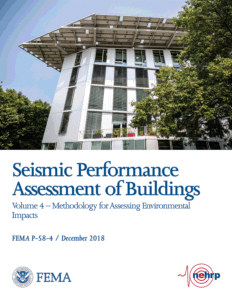Scopo della ricerca:
Sviluppare un database completo di riparazione di componenti edilizie strutturali e non
Di
Nella valutazione del impatto ambientale del ciclo di vita degli edifici, the contributions of seismic damage are rarely considered. This project developed and analyzed the largest known environmental impact database of building component seismic damage. By extending established methods of probabilistic seismic performance evaluation to include environmental impacts, a more comprehensive assessment of a building’s expected seismic performance can be evaluated.
To calculate the environmental impacts, data from Carnegie Mellon University’s Green Design Institute’s Economic Input-Output Life Cycle Analysis (LCA) database were connected to previously established repair cost estimate data. Environmental impacts, including embodied carbon, embodied energy, and other metrics, were calculated for the repair of nearly 800 building components under three or more different seismic damage levels. This database was developed to support the Federal Emergency Management Agency’s (FEMA) Performance Assessment Calculation Tool (PACT) as a part of Progetto FEMA P-58.
Risultati
Lavoro di valutazione ambientale per FEMA P-58 può essere trovato in:
- FEMA-P-58-4: "Volume 4 - Metodologia per la valutazione degli impatti ambientali"
- Documentazione di base, sezione 3.7.20: "Metodologia per la valutazione dell'impatto ambientale" (file zip)
Pubblicazioni su riviste
- Simonen, Huang, Aicher e Morris. (2018). Carbonio incorporato come indicatore dell'impatto ambientale della riparazione dei danni causati dal terremoto. Energia ed edifici.
- Huang & Simonen. (2020). Analisi ambientale comparativa dei danni sismici negli edifici. Giornale di ingegneria strutturale.
Gruppo di ricerca
- K. Simonen (UW), PI
- M. Huang (UW)
- P. Morris (AECOM)
Ringraziamenti
Questo materiale si basa sul lavoro finanziato dalla Federal Emergency Management Agency e gestito dall'Applied Technology Council (ATC) attraverso il progetto ATC 58-2, la cui sostanza è dedicata al pubblico. Tutte le opinioni, i risultati e le conclusioni o le raccomandazioni espresse nel materiale sono quelle degli autori e non riflettono necessariamente le opinioni della Federal Emergency Management Agency o dell'Applied Technology Council.
Additional contributions from John Hooper, Anthony Court, Wayne Trusty, Mark Webster, and Jon Heinz. We thank Chris Aicher and Professor Paul Sampson from the Department of Statistics at the University of Washington for their assistance and advisement in the statistical component of this work. We also thank Ibrahim Almufti, his team at ARUP, and Kristen Strobel, a graduate student at the University of Washington, for their work in providing the data for the case study building as well as H. Scott Matthews at Carnegie Mellon University for his advice regarding the use of their EIO LCA database.
We would also like to acknowledge John Gillengerten, who developed the PACT model files for the case study buildings and provided guidance on their use; Vesna Terzic, who evaluated the case study buildings during their development; Scott Hagie and Russell Larson, who provided additional support for the PACT software; and Ayse Hortacsu for additional information about PACT.
